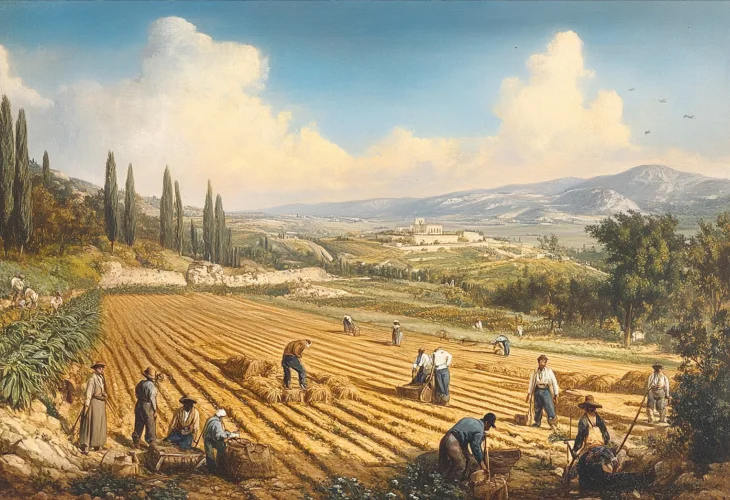Rediscovering the Roots: Embracing the Land of Israel
While there was no ideological opposition to work, including agricultural work, ensuring Torah scholars could continue their learning was always prioritized. Historically, the Tribe of Levi and their affiliates focused on holy work, a tradition rooted in Jewish consciousness, recognizing the spiritual vitality of Torah study.

Contrary to the stereotype of the Old Yishuv, they did not believe in relying on funds from abroad. They repeatedly attempted to settle on the land, but given the conditions at the time, they were unsuccessful.
In a joint letter from the Jewish leaders in Safed, it was written: "Provide them with some trade or craft, even field work... Due to the severe hardship and the love for settling the land, they will undertake such work... in this way, the scholars will sit on Torah and their work, while the rest of the people will engage in their crafts."
While there was no ideological opposition to work, including agricultural work, ensuring Torah scholars could continue their learning was always prioritized. Historically, the Tribe of Levi and their affiliates focused on holy work, and it was clear to everyone that the spiritual survival of the Jewish people depended above all on those who studied Torah.
Dr. Morgenstern reveals, from letters of the time, an unknown fact: there were small-scale attempts at agriculture in the past. "As we knew from past years, they planted potatoes brought from Poland, which the Ishmaelites uprooted before they fully grew, and they had none left for replanting." In other words, the delays in agricultural settlement stemmed not from ideological opposition, but from objective challenges, including serious security issues at the time.
We did not, heaven forbid, come to diminish the work of Sir Montefiore, but merely to highlight the efforts of the Old Yishuv members and the fact that even as they stood on the eve of the Jewish year 5600, anticipating redemption, they did not neglect the economic stability of the settlement. Dr. Morgenstern emphasizes that the settlement of the land was seen by the Orthodox leadership of the time not as a mundane solution to the daily survival issues of the residents, but as part of the mitzvah of settling the Land of Israel, a crucial instrument to hasten redemption.
Dr. Morgenstern cites a letter from the leadership of the Ashkenazi and Sephardi communities to Montefiore during his visit in 1839, advocating for Jewish agricultural work: "By granting them a foothold in the Holy Land, the land of Israel, to plow and sow and harvest joyfully, each man may dwell peacefully under his vine and fig tree... Those who revere Hashem and contemplate His name will stand on their guard, on the Torah and the work, while the rest of the folk will work the holy land." They request: "Let Moses [Montefiore] swiftly secure a decree from the Egyptian monarch with all necessary strength and authority for this endeavor."
The letter was signed by major Ashkenazi rabbis in Jerusalem: Rabbi Natan Neta, son of Rabbi Menachem Mendel of Shklov, Rabbi Yeshayahu Bardaki, Rabbi Aryeh Neman, and also Sephardi leaders.
Dr. Morgenstern quotes another letter indicating a general desire in the settlement to sustain themselves: "...and most of them wish to support themselves by the work of their hands on the holy land, to eat of its fruits and be satisfied with its goodness."
Who was Montefiore himself, and what drove him to invest his fortune and energy in the Land of Israel? Montefiore was a religious man, a tefillin wearer, and a man of prayer: "As a loyal guardian of Jewish tradition, he held Jerusalem's rabbis in high regard and sought to coordinate all his actions with them."
His personal secretary for thirty years, Rabbi Eliezer HaLevi, a disciple of the Chatam Sofer, was an eminent scholar and God-fearing man. Along with his wife and secretary, Montefiore took on his travels... a shochet. In his diary, he wrote: "Gradually, I hope to inspire the return of thousands of our brethren to the Land of Israel. I am assured they will be happy due to the joy of maintaining our holy religion in a manner not possible in Europe."
Yet, events did not unfold as planned. These initiatives by the Old Yishuv and Montefiore didn’t bear fruit because Muhammad Ali feared a Jewish settlement in the Land of Israel and did not promptly respond to Montefiore’s proposal. While delaying, the land was seized from his hands by the Turks, who regained control.
Thus, there is no doubt that the nature of the immigration during this early 19th-century era is far from deserving the label "Old Immigrants," as assigned by local historiography to these pioneers. Before us is a dynamic and vibrant aliyah from all over the Jewish world, eager to settle the land and ready to make significant sacrifices for this cause. Settlement of the land was already perceived in these early years as a broad concept, encompassing not only a desire to engage in agriculture but also attempts to develop commerce and industry, of course, in the context of the time and considering the challenges of that period, as we will continue to describe.

